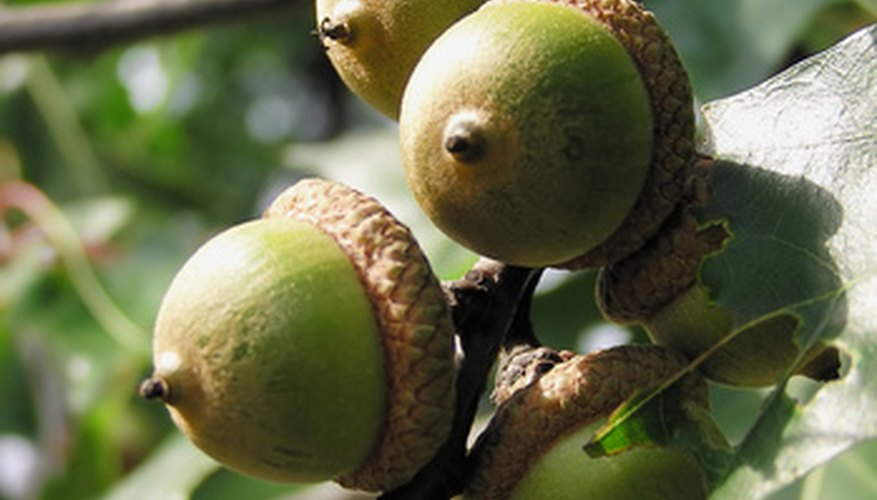The transformation of a tiny acorn into a huge oak tree comes after an intricate chain of events. Before an oak can grow to a grand old age, nature must first oversee the process of pollenation, fertilisation and dispersal of the seeds. Oak tree reproduction takes place between spring and autumn.
Male and Female Flowers
Oaks are classified as being monoecious, which means they produce both male and female flowers. In spring, oak trees grow male flowers called staminate and female equivalents known as pistillate on the same tree. The flowers are a mixture of yellow and green in appearance.
Pollenation
In early spring, the male flowers grow into a thin, wormlike shape known as a catkin or an ament. The flowers consist of pollen-producing stamens that release pollen into the air before eventually falling to the ground once they are spent. Fallen catkins can often be seen in spring at the foot of oak trees.
Fertilisation
Fertilisation occurs when the yellow mist of the airborne pollen comes to rest on a receptive stigma in the female flower, with a little help from the wind. The female flowers grow where the leaf stalks meet the branches or twigs. Fertilised flowers grow into acorns that sit in hard cups called peduncles.
Dispersing the Acorn
By autumn the acorns have ripened and, before the leaves of the tree are shed, they fall to the ground. However some types of oak trees produce acorns at a different rate than others. White oaks, for example, need only one growing season from the time of pollination to the acorn ripening. In contrast, red oaks need two growing seasons. Once the acorns fall to the ground, the subsequent shedding of the tree's leaves acts as a deterrent to acorn-eating animals and birds by covering and hiding the acorns on the forest floor. Of course this only serves to reduce the amount of acorns scavenged by the creatures, and only a small proportion the seeds will remain intact and go on to mature into adult oak trees. However, animals that do get their claws and paws on the acorns do not necessarily have an entirely negative impact on the success of the oak tree population. A study by scientists at the North American universities of Wilkes and Richmond, as quoted in an article on the website of the research industry publication Science Daily, claims that grey squirrels are an aid to the regeneration and dispersal of oaks, as they rarely eat all the acorns they scavenge and hide away, meaning some of these acorns survive and grow into oak trees.
- By autumn the acorns have ripened and, before the leaves of the tree are shed, they fall to the ground.
- A study by scientists at the North American universities of Wilkes and Richmond, as quoted in an article on the website of the research industry publication Science Daily, claims that grey squirrels are an aid to the regeneration and dispersal of oaks, as they rarely eat all the acorns they scavenge and hide away, meaning some of these acorns survive and grow into oak trees.
Reproduction Rates
According to the global environmental organisation The Nature Conservancy, oaks can start reproducing from the age of 20, but more commonly it is not until they are between 40 and 50 that acorns are successfully produced. While trees may produce very few acorns in a particular year, every three to five years they enjoy a "mast" year in which they can produce tens of thousands of acorns.
